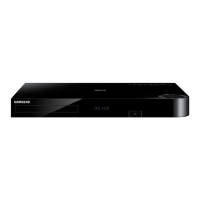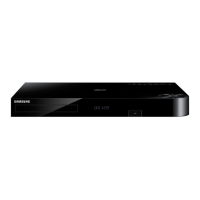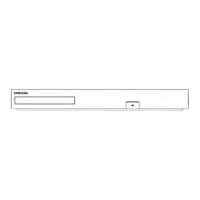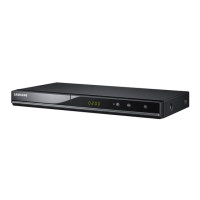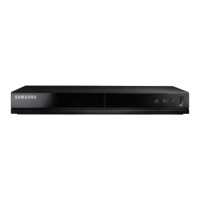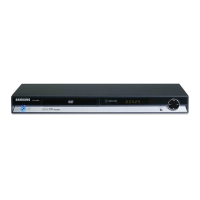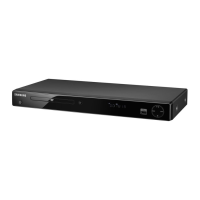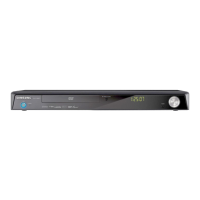Why doesn't the disc menu appear on my Samsung DVD Player?
- DdriceSep 6, 2025
If the disc menu does not appear on your Samsung DVD Player, ensure that the disc actually has disc menus.
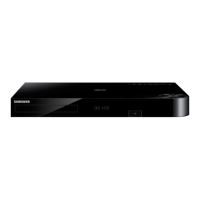
Why doesn't the disc menu appear on my Samsung DVD Player?
If the disc menu does not appear on your Samsung DVD Player, ensure that the disc actually has disc menus.
What does the prohibition message mean on my Samsung BD-H8500 DVD Player?
The prohibition message appears when an invalid button is pressed, the Blu-ray Disc/DVD's software doesn’t support the feature (e.g., angles), or you’ve requested a title or chapter number or search time that is out of range.
Why does play mode differ from Setup Menu selection on Samsung BD-H8500 DVD Player?
Some of the functions selected in the Setup Menu may not work properly if the disc is not encoded with the corresponding function.
Why can't I change the screen ratio on my Samsung DVD Player?
The screen ratio cannot be changed because the Screen Ratio is fixed on your Blu-ray/DVD disc. This is not a problem with the product.
What causes an abnormal HDMI output screen on a Samsung DVD Player?
If random noise appears on the screen, it means that TV does not support HDCP (High-bandwidth Digital Content Protection).
Why can't I see files in shared folders on my Samsung BD-H8500?
The multimedia list shows only files corresponding to the Videos, Photos, and Music categories. Files that do not correspond to these categories may not be displayed.
| Depth | 282 mm |
|---|---|
| Width | 430 mm |
| Height | 55 mm |
| Weight | 2700 g |
| Display | VFD |
| Device type | Blu-Ray player |
| Built-in HDD | Yes |
| HDD capacity | 500 GB |
| Product color | Black |
| Audio decoders | Dolby Digital, Dolby Digital Plus, Dolby TrueHD, DTS Digital Surround, DTS-HD Master Audio |
| Package weight | 3600 g |
| AC input voltage | 220 - 240 V |
| AC input frequency | 50 Hz |
| Disc types supported | BD, CD-R, CD-RW, DVD, DVD+R, DVD+RW, DVD-R, DVD-RW |
| Supported video modes | - |
| Card reader integrated | No |
| USB 2.0 ports quantity | USB 2.0 ports have a data transmission speed of 480 Mbps, and are backwards compatible with USB 1.1 ports. You can connect all kinds of peripheral devices to them. |
| Audio formats supported | AAC, LPCM, MP3, WMA |
| Image formats supported | JPG |
| Video formats supported | AVCHD, DIVX, DIVX HD, MKV, MPEG2, MPEG4, WMV |
| Power consumption (standby) | 1 W |
| Power consumption (typical) | 32 W |
| Digital signal format system | DVB-C, DVB-T |
| Audio output channels | 7.1 channels |
Instructions for connecting the product to a television set via HDMI or other methods.
Steps to connect the Blu-ray player to an audio receiver using HDMI or optical inputs for enhanced sound.
Guides for establishing a wired or wireless network connection between the product and a router.
Adjusts video output settings like resolution, aspect ratio, and picture modes for optimal display.
Configures audio output options, including digital output formats, downmixing, and audio sync.
Manages TV channel tuning, scanning, list management, and other broadcast-related configurations.
Manages network connectivity, status, Wi-Fi, and remote access features for online services.
Instructions for playing photos, videos, and music from USB devices, computers, or cloud services.
Explains how to control video playback using remote buttons and menu options.
Details on controlling music playback, including track selection, playlists, and ripping.
Guides on recording TV programs, managing storage, pausing, and stopping recordings.
Explains how to pause and rewind live TV broadcasts using the Timeshift feature.
Downloading, installing, and managing applications from the Samsung Apps store.
Instructions for displaying your smartphone or tablet screen on the TV.
Common problems and their solutions to help users resolve issues with the device.
Steps for connecting to an AV receiver that supports HDMI for audio and video transfer.
How to connect to an AV receiver using an optical audio cable for sound output.
Setup guide for establishing a stable internet connection using an Ethernet LAN cable.
Enables Ultra High Definition video output, requiring a compatible TV and content.
Options to select how 3D content is displayed, including auto-detection and specific modes.
Selects the digital audio output format to match the connected AV receiver's capabilities.
Corrects audio delay issues to ensure synchronization between audio and video signals.
Scans for and stores available TV channels automatically for easy channel access.
Verifies the current network connection status and internet connectivity.
Guides through setting up wired or wireless network connections, including IP address configuration.
Configures notification settings and views basic information for installed applications.
Steps to connect and play photos, videos, and music files stored on a USB flash drive.
Instructions for streaming media files from networked computers or mobile devices using DLNA.
Navigating menus to view, filter, and manage recorded TV titles.
Utilizes the options menu for recorded titles, including play, lock, unlock, delete, and rename functions.
Instructions for selecting, downloading, and installing applications from the Samsung Apps store.
Configures homepage, pop-up blocking, page blocking, general settings, encoding, pointer, and browser information.
Lists supported video file extensions, containers, codecs, resolutions, frame rates, bit rates, and audio codecs.
Specifies supported music file extensions, types, codecs, and their respective support ranges.
